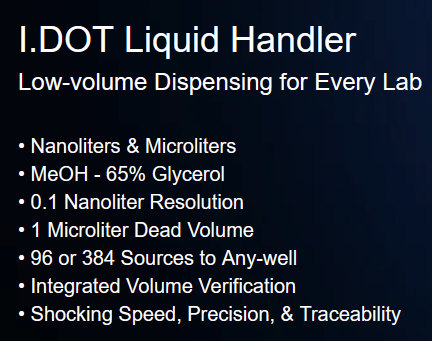The Dispendix I.Dot, the Dragonfly and the Certus Flex are all very good devices and it can be used for your application.
I’ve always seen the I.Dot like the competitor to the Echo, but it can take a deep well plate - the echo cannot.
Dragonfly is an amazing device and actually, we at Synthace are partners with them so I can connect you to the right people if you need it.
What I like about the dragonfly is its very quick ease of use. You simply set up the experiment, add in tips and away it goes. It’s extremely fast especially if you go with the 10-head configuration. When the plate is underneath the tips, all 10 can dispense at the same time. It’s also liquid class agnostic so I don’t have to worry the liquids I’m using, it auto-detects and auto adjusts.
This isn’t a con, but it’s a limiting factor, which is the reservoirs. It can only take in 10, which means if you have more than 10 reagents you have to split your experiment in layers.
I tried to do a setup guide actually here
The Certus Flex is another amazing device, the same as the dragonfly it’s very fast. The difference is that it’s 8 channels, not 10. However, the major benefits of the Certus Flex is sustainability. What you buy is what you get and use forever. Everything is reusable and autoclavable. What I also like about it is the configurations it has. You can get a stirrer module for cell work, and the tubing can go into any labware. You can have a big bottle sitting on a stirrer to keep reagents homogenous or have it sitting in an ice bath, so that’s cool.
And yes I have a video showing this
For the Certus it’s limiting again to the number of reagents, as it can only dispense 8 at a time, but you can set different layers so it just means switching out the reagents. Synthace works with the Certus Flex so again if you need assistance I can connect you to the right people.
I don’t have videos of the I.Dot but just know it’s a very capable device. You can’t go wrong with any of those 3 for the use case you described.
The Mantis is really good too as mentioned above and it can have up to 48 reagents. It’s also very very small, so it doesn’t take up much space at all. The downside to it though is the speed, it dispenses one reagent at a time instead of multiple like the other devices.
Hope all this helps!
Any questions do reach out.
